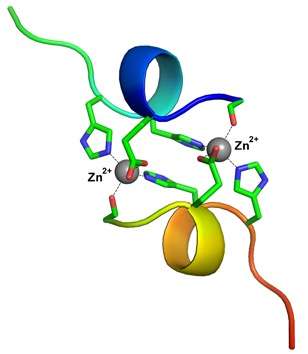The structure of the complex of β-amyloid fragment -- the product of Taiwanese mutation, with zinc ions. Credit: Vladimir Polshakov.
Members of the Faculty of Fundamental Medicine at the Lomonosov Moscow State University have determined the structure of a peptide complex formed in the brain at the early stages of Alzheimer's disease. The research results will contribute to the rational design of compounds to block the progress of the disease.
Alzheimer's disease is associated with the aggregation of amyloid-β peptide in the human brain. The scientific team from the Lomonosov Moscow State University, under the leadership of chemist Vladimir Polshakov, has studied molecular mechanisms of β-amyloid aggregation among the carriers of pathogenic familial Taiwanese mutation, and described the structure of emerging complexes to establish the role of zinc ions (Zn2+) in their formation.
β-Amyloid is a small peptide with important physiological functions, for instance, protecting the brain from potential pathogenic agents. Normally, after fulfilling its functions the peptide is cleaved by proteases and utilized. However, in some cases, molecules of this peptide start binding with each other, forming complexes that are toxic to neurons. Processes of β-amyloid aggregation into such complexes are initiated by transition metal ions.
Over several years, the scientists from the Lomonosov Moscow State University, in cooperation with their colleagues from the Engelhardt Institute of Molecular Biology, have studied the molecular mechanism of zinc-mediated aggregation of β-amyloid peptide. They have chosen the peptide carrying the Taiwanese mutation as a model. Alzheimer's disease inevitably progresses among the carriers of such mutations at a relatively young age. The researchers have revealed that the structure of the β-amyloid complexes, consisting of mutant peptides, turns out to be tighter and more stable compared to the complexes from native peptides. Zinc ions (Zn2+) play a key role in their formation.
Vladimir Polshakov comments: "We were surprised to see that interaction between a fragment of this peptide and zinc ions has led to formation of a stable complex, where two peptide chains are tightly fastened by two zinc ions. Similar binuclear structures haven't been described in the literature yet. Notably, interaction between metal ions and β;-amyloid peptides usually leads to a variety of peptide chain conformations. The emerging complexes are sort of 'breathing,' passing from one conformation to another. But in case of the peptide, we observe only a single conformation, which allowed us to determine its structure with high accuracy and precision using nuclear magnetic resonance spectroscopy."
The obtained results will contribute to compounds capable of blocking zinc-mediated β-amyloid aggregation, which, in its turn, would stop the progress of Alzheimer's disease at early stages. Vladimir Polshakov says, "Using the information on the molecular mechanism revealed in this project, which initiates pathogenic aggregation of β-amyloid peptide, our colleagues from the Engelhardt Institute of Molecular Biology have already taken out patents for two compounds, capable of terminating β-amyloid aggregation. Studies of properties of these compounds on animal models have proved that they are able to reduce by several times the risk disease progression."
More information: Vladimir I. Polshakov et al, A Binuclear Zinc Interaction Fold Discovered in the Homodimer of Alzheimer's Amyloid-β Fragment with Taiwanese Mutation D7H, Angewandte Chemie International Edition (2017). DOI: 10.1002/anie.201704615
Journal information: Angewandte Chemie International Edition
Provided by Lomonosov Moscow State University






















